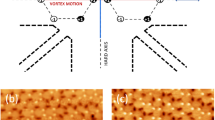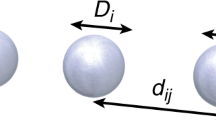Abstract
Initially inspired by biological motors, new types of nanodevice have been proposed for controlling the motion of nanoparticles. Structures incorporating spatially asymmetric potential profiles (ratchet substrates) have been realized experimentally to manipulate vortices in superconductors, particles in asymmetric silicon pores, as well as charged particles through artificial pores and arrays of optical tweezers. Using theoretical ideas, we demonstrate experimentally how to guide flux quanta in layered superconductors using a drive that is asymmetric in time instead of being asymmetric in space. By varying the time-asymmetry of the drive, we are able experimentally to increase or decrease the density of magnetic flux at the centre of superconducting samples that have no spatial ratchet substrate. This is the first ratchet without a ratchet potential. The experimental results can be well described by numerical simulations considering the dragging effect of two types of vortices penetrating layered superconductors in tilted magnetic fields.
This is a preview of subscription content, access via your institution
Access options
Subscribe to this journal
Receive 12 print issues and online access
$259.00 per year
only $21.58 per issue
Buy this article
- Purchase on Springer Link
- Instant access to full article PDF
Prices may be subject to local taxes which are calculated during checkout






Similar content being viewed by others
References
Hänggi, P., Marchesoni, F. & Nori, F. Brownian motors. Ann. Phys. (Leipz.) 14, 51–70 (2005).
Hänggi, P. & Marchesoni, F. Introduction: 100 years of Brownian motion. Chaos 15, 026101 (2005).
Linke, H. et al. Experimental tunneling ratchets. Science 286, 2314–2317 (1999).
Linke, H. (ed.) Ratchets and Brownian motors: Basics, experiments and applications. Appl. Phys. A 75 (special issue), 167 (2002).
Matthias, S. & Muller, F. Asymmetric pores in a silicon membrane acting as massively parallel brownian ratchets. Nature 424, 53–57 (2003).
Rousselet, J., Salome, L., Ajdari, A. & Prost, J. Directional motion of Brownian particles induced by a periodic asymmetric potential. Nature 370, 446–448 (1994).
Derényi, I., Lee, C. & Barabási, A. L. Ratchet effect in surface electromigration: Smoothing surfaces by an ac field. Phys. Rev. Lett. 80, 1473–1476 (1998).
Wambaugh, J. F. et al. Superconducting fluxon pumps and lenses. Phys. Rev. Lett. 83, 5106–5109 (1999).
Olson, C. J. et al. Collective interaction-driven ratchet for transporting flux quanta. Phys. Rev. Lett. 87, 177002 (2001).
Zhu, B. Y. et al. Controlling the motion of magnetic flux quanta. Phys. Rev. Lett. 92, 180602 (2004).
Lee, C.-S. et al. Reducing vortex density in superconductors using the ‘ratchet effect’. Nature 400, 337–340 (1999).
Kwok, W. K. et al. Modification of vortex behavior through heavy ion lithography. Physica C 382, 137–141 (2002).
Villegas, J. E. et al. A superconducting reversible rectifier that controls the motion of magnetic flux quanta. Science 302, 1188–1191 (2003).
Van de Vondel, J. et al. Vortex-rectification effects in films with periodic asymmetric pinning. Phys. Rev. Lett. 94, 057003 (2005).
Togawa, Y. et al. Direct observation of rectified motion of vortices in a niobium superconductor. Phys. Rev. Lett. 95, 087002 (2005).
Wördenweber, R., Dymashevski, P. & Misko, V. R. Guidance of vortices and the vortex ratchet effect in high-Tc superconducting thin films obtained by arrangement of antidots. Phys. Rev. B 69, 184504 (2004).
Majer, J. B., Peguiron, J., Grifoni, M., Tusveld, M. & Mooij, J. E. Quantum ratchet effect for vortices. Phys. Rev. Lett. 90, 056802 (2003).
Shalom, D. E. & Pastoriza, H. Vortex motion rectification in Josephson junction arrays with a ratchet potential. Phys. Rev. Lett. 94, 177001 (2005).
Siwy, Z. & Fuli’nski, A. Fabrication of a synthetic nanopore ion pump. Phys. Rev. Lett. 89, 198103 (2002).
Marquet, C. et al. Rectified motion of colloids in asymmetrically structured channels. Phys. Rev. Lett. 88, 168301 (2002).
Grier, D. G. A revolution in optical manipulation. Nature 424, 810–816 (2003).
Gopinathan, A. & Grier, D. G. Statistically locked-in transport through periodic potential landscapes. Phys. Rev. Lett. 92, 130602 (2004).
Lee, S., Ladavac, K., Polin, M. & Grier, D. G. Observation of flux reversal in a symmetric optical thermal ratchet. Phys. Rev. Lett. 94, 110601 (2005).
You, J. Q. & Nori, F. Superconducting circuits and quantum information. Phys. Today 58, 42–47 (2005).
Morais-Cabral, J. H. et al. Energetic optimization of ion conduction rate by the K+ selectivity filter. Nature 414, 37–42 (2001).
Matsuda, T. et al. Oscillating rows of vortices in superconductors. Science 294, 2136–2138 (2001).
Grigorenko, A., Bending, S., Tamegai, T., Ooi, S. & Henini, M. A one-dimensional chain state of vortex matter. Nature 414, 728–731 (2001).
Vlasko-Vlasov, V. K. et al. Decoration of Josephson vortices by pancake vortices in Bi2Sr2CaCu2O8+δ . Phys. Rev. B 66, 014523 (2002).
Tokunaga, M. et al. Visualization of vortex chains in Bi2Sr2CaCu2O8+y by magneto-optical imaging. Phys. Rev. B 66, 060507(R) (2002).
Ooi, S. et al. Vortex matter transition in Bi2Sr2CaCu2O8+y under tilted fields. Phys. Rev. B 63, 20501(R) (2001).
Ooi, S. et al. Novel angular scaling of vortex phase transitions in Bi2Sr2CaCu2O8+y . Phys. Rev. Lett. 82, 4308–4311 (1999).
Mirković, J. et al. Stepwise behavior of vortex-lattice melting transition in tilted magnetic fields in single crystals of Bi2Sr2CaCu2O8+δ . Phys. Rev. Lett. 86, 886–889 (2001).
Savel’ev, S. & Nori, F. Experimentally realizable devices for controlling the motion of magnetic flux quanta in anisotropic superconductors. Nature Mater. 1, 179–184 (2002).
Savel’ev, S., Marchesoni, F. & Nori, F. Manipulating small particles in mixtures far from equilibrium. Phys. Rev. Lett. 92, 160602 (2004).
<http://dml.riken.go.jp/vortex>; http://staff.bath.ac.uk/pyssb/1DMovies.htm.
Bulaevskii, L. N., Ledvij, M. & Kogan, V. G. Vortices in layered superconductors with Josephson coupling. Phys. Rev. B 46, 366–380 (1992).
Koshelev, A. E. Crossing lattices, vortex chains, and angular dependence of melting line in layered superconductors. Phys. Rev. Lett. 83, 187–190 (1999).
Savel’ev, S. E., Mirković, J. & Kadowaki, K. London theory of the crossing vortex lattice in highly anisotropic layered superconductors. Phys. Rev. B 64, 094521 (2001).
Perkins, G. J., Caplin, A. D. & Cohen, L. F. Dynamic interactions between pancake vortex stacks and Josephson vortices in Bi2Sr2CaCu2O8+δ single crystals: relaxation and ratchets. Supercond. Sci. Technol. 18, 1290–1293 (2005).
Motohira, N. et al. Single crystal growth of Bi2Sr2Can−1CunOy superconductors by the floating zone method. J. Ceram. Soc. Jpn 97, 1009–1014 (1989).
James, M. S., Stoddart, S. T. & Bending, S. J. Field penetration and surface barriers in superconducting Bi2Sr2CaCu2O8+δ whiskers. Phys. Rev. B 56, R5771–R5773 (1997).
Koshelev, A. E. Kink walls and critical behavior of magnetization near the lock-in transition in layered superconductors. Phys. Rev. B 48, 1180–1191 (1993).
Avraham, N. et al. ‘Inverse’ melting of a vortex lattice. Nature 411, 451–454 (2001).
Savel'ev, S. E. & Gorbachev, V. S. Microscopic model of critical state for the hard superconductor. JETP 83, 570–581 (1996).
Acknowledgements
We gratefully acknowledge support from the EPSRC (UK) under grant No. GR/R46489/01, the ESF VORTEX network, the US NSA and ARDA under AFOSR contract No. F49620-02-1-0334, NSF grant No. EIA-0130383, and a Grant-in-Aid for Scientific Research from MEXT, Japan.
Author information
Authors and Affiliations
Corresponding author
Ethics declarations
Competing interests
The authors declare no competing financial interests.
Rights and permissions
About this article
Cite this article
Cole, D., Bending, S., Savel'ev, S. et al. Ratchet without spatial asymmetry for controlling the motion of magnetic flux quanta using time-asymmetric drives. Nature Mater 5, 305–311 (2006). https://doi.org/10.1038/nmat1608
Received:
Accepted:
Published:
Issue Date:
DOI: https://doi.org/10.1038/nmat1608
This article is cited by
-
Multiple current reversals and negative differential mobility induced by a periodic kick force
Indian Journal of Physics (2023)
-
Superconducting diode effect via conformal-mapped nanoholes
Nature Communications (2021)
-
Josephson vortex loops in nanostructured Josephson junctions
Scientific Reports (2018)
-
Tuning the structure of the Josephson vortex lattice in Bi2Sr2CaCu2O8+δ single crystals with pancake vortices
Scientific Reports (2018)
-
Current-driven production of vortex-antivortex pairs in planar Josephson junction arrays and phase cracks in long-range order
Scientific Reports (2018)



